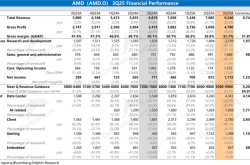Masayoshi Son's AI Vision: Navigating Challenges and Opportunities to Build the Next NVIDIA
![]() 12/26 2024
12/26 2024
![]() 484
484
(This article is approximately 1,625 words long and will take roughly 4 minutes to read)

In the ever-evolving landscape of the global semiconductor industry, Masayoshi Son, the visionary founder and chairman of Japan's SoftBank Group, has once again captured headlines. He has unveiled plans to invest $200 billion in the United States over the next four years. Amidst the rapid proliferation of AI technology worldwide, Son has quietly unveiled his ambitious plans for AI. Sources indicate that he aims to create an AI powerhouse comparable to NVIDIA through SoftBank's chip business, aiming to dominate the AI hardware market. This endeavor not only involves billions of dollars in investment but also holds the potential to redefine the entire semiconductor industry.
Masayoshi Son's ambition in AI is not merely a fleeting idea. SoftBank already holds a 90% stake in Arm, the British chip designer, which has become the crown jewel of SoftBank's investment portfolio. For years, Son has been contemplating how to leverage Arm's expertise to penetrate the AI sector, transcend the limitations of GPU technology, develop more efficient AI chips, and thereby challenge industry titans like NVIDIA.
In 2024, Masayoshi Son injected fresh momentum into SoftBank's AI strategy by acquiring Graphcore, a British AI chip manufacturer. By collaborating with Arm, SoftBank is accelerating the development of its proprietary AI accelerators. Industry insiders widely agree that SoftBank's move is not only fueled by the vast potential of the current AI market but also anticipates the rapid growth and technological shifts expected in the future of AI accelerators. As Chris Miller, author of "Chip War," observes, "The market is poised for monumental shifts, making SoftBank's actions all the more significant."
Masayoshi Son's ambitions extend beyond this acquisition. It is understood that he intends to name SoftBank's AI chip project "Izanagi" and raise up to $100 billion for its development. The name Izanagi, inspired by the Japanese mythological deity who created the world, embodies the spirit of groundbreaking innovation from scratch. Furthermore, sources suggest that Son might leverage the resources of ultra-large-scale manufacturers to amplify tens of billions of dollars into hundreds of billions, realizing this audacious goal.
Masayoshi Son has also been in frequent discussions with Sam Altman, CEO of OpenAI, another pivotal figure in the AI realm. Their conversations encompass large language models and the semiconductor shortages plaguing AI applications. Given the high cost of NVIDIA's GPUs, each priced at tens of thousands of dollars, Son recognizes that to gain a foothold in this market, he must develop AI chips that can compete with NVIDIA. To this end, Son and Altman have discussed the need for massive investments ranging from $3 trillion to $7 trillion.
Apart from collaborating closely with OpenAI, Masayoshi Son is acutely aware of the technical expertise required. Through extensive conversations with Arm CEO René Haas, Son has refined the intricacies of the Izanagi project. Despite their disagreements on certain aspects, Haas's extensive experience in chip design continues to support Son's ambitions. As Haas notes, Arm's transformation aligns with Son's grand vision, and despite the challenges ahead, Arm's future success is inextricably linked to SoftBank's strategic guidance and capital support.
However, Masayoshi Son's journey towards AI chips is fraught with obstacles. While SoftBank excels in capital markets, it lacks substantial experience in chip manufacturing. The semiconductor industry is far more intricate than other fields, requiring sophisticated technology and substantial capital investments for chip design, manufacturing, and mass production. Even NVIDIA, which faced bankruptcy risks due to capital chain disruptions, overcame these hurdles with TSMC's manufacturing support for its latest chips.
Currently, SoftBank's AI chip plan is confronted with fierce market competition. Established giants like NVIDIA and AMD dominate a significant share of the AI hardware market, with NVIDIA's GPUs becoming the de facto standard for deep learning due to their unparalleled performance. For SoftBank, breaking this technological barrier and introducing competitive products remains a formidable challenge.
Moreover, competition in the chip design domain is intensifying, with the AI accelerator market expected to undergo significant changes over the next one to two years. While most existing AI accelerators are primarily used for training, the demand for future predictions and inferences will soar. Adapting the technological path to align with market demands will be crucial for the success of SoftBank's chip plan.
Another hurdle for Masayoshi Son is building a comprehensive AI ecosystem beyond chip hardware. NVIDIA is not merely a chip manufacturer but also a significant driver of the deep learning and AI technology ecosystem. To compete in this realm, SoftBank must leverage Arm's intellectual property and Graphcore's technological accumulations to swiftly construct a hardware and software collaborative innovation platform akin to NVIDIA. This poses not only technical challenges but also tests of capital and time.
Beyond technology and capital, Masayoshi Son must also address manufacturing and capacity issues. Currently, TSMC remains the world's foremost semiconductor foundry, making SoftBank's partnership with TSMC critically important. While TSMC leads in technology, SoftBank may also collaborate with other partners to ensure capacity and technical support to meet future market demands.
*Disclaimer: The above content is compiled from online sources and is intended solely for exchange and learning purposes. If there are any content or copyright concerns, please contact us for prompt removal.








